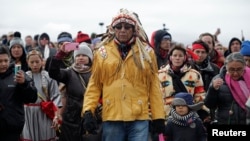The majority of protesters trying to block the building of an oil pipeline through Native American land in the U.S. state of North Dakota returned to near their base camp Saturday morning after two days of escalated tensions between them and the police.
About a half dozen law enforcement vehicles remained parked near the site Saturday morning.
Friday, the day after protests escalated and resulted in over 100 arrests, just over 50 people returned to the site where barricades were set ablaze on a bridge over the Missouri River — the main source of water for the Standing Rock Sioux Tribe.
Protesters were "nonconfrontational but uncooperative," said Morton County Sheriff Kyle Kirchmeier, thanking members of the Standing Rock tribe for helping to ease tensions.
Native Americans and their supporters say the Dakota Access Pipeline will put the local water supply at risk and damage areas sacred to the tribe.
Protests had been intensifying since July, when a permit was obtained to route the pipeline beneath the Missouri River at Lake Oahe, less than 1 kilometer from the Standing Rock Sioux Indian Reservation.









